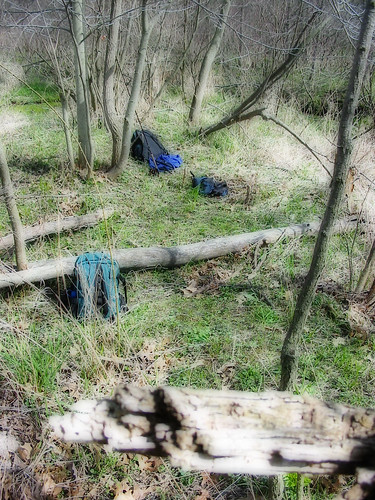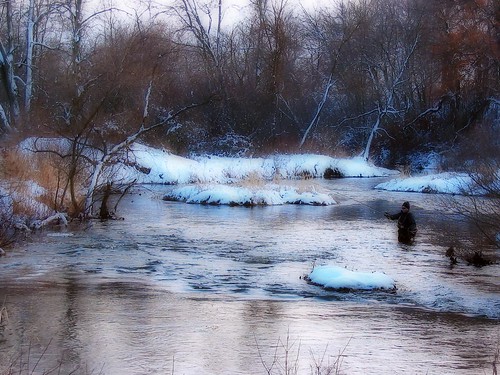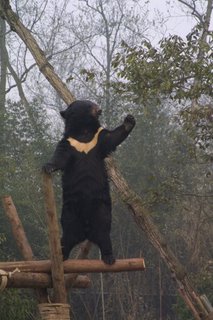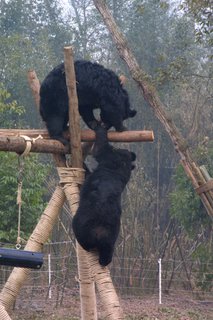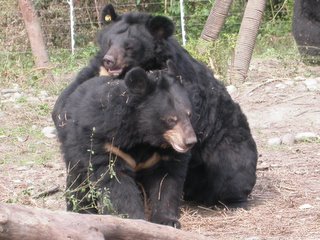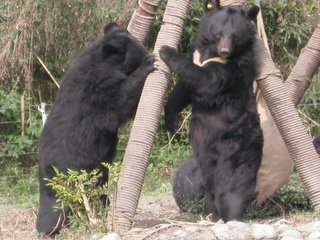Anyone lose a tail feather?
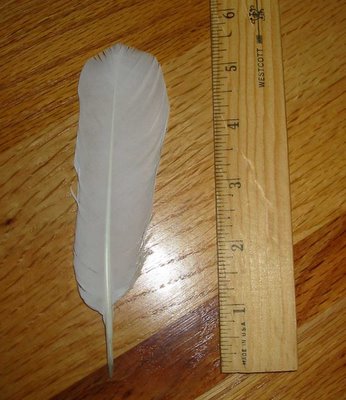 I need help solving a minor mystery. B found this feather while out hiking around our field and the neighbor's woods this past weekend. I'm guessing it's a tail feather due to the blunt, squared tip. It's about 5 1/2 inches in length, a bit over 1 inch in width and is close, but not quite symmetrical. From the size, I'd guess that this feather does not belong to a small bird, but instead to a gull-sized bird or larger.
I need help solving a minor mystery. B found this feather while out hiking around our field and the neighbor's woods this past weekend. I'm guessing it's a tail feather due to the blunt, squared tip. It's about 5 1/2 inches in length, a bit over 1 inch in width and is close, but not quite symmetrical. From the size, I'd guess that this feather does not belong to a small bird, but instead to a gull-sized bird or larger.
A white feather is an unusual find in our immediate vicinity - which could be described as open grassland with intermittent stands of pine, mixed non-climax hardwoods and wetlands.
I'm not aware of any chickens or domestic geese in our immediate area, but I certainly couldn't categorically rule them out. Who else has white 5 1/2" tail feathers? I don't think Canada geese have any white tail feathers. We don't typically have much in the way of water birds this time of year, though many could have passed over or through temporarily.
Whaddya think?
I tried Cindy's Photoshop technique
It was very exciting to read Cindy's blog and see that there is a simple Photoshop process to create beautiful softened images like hers. I gave it a whirl and these are two of my first few attempts. I like the results, but I think it would help even more to start with gorgeous photos like Cindy's...
Technorati tag(s): blogs & links, nature
WaPo article on 'irreparable climate change'
Here's a pretty good mainstream media article on the iminent and potentially irreversible dangers of global warming. James Hansen, a prominent NASA climate scientist is quoted in the article. He's the same guy that's been in the news several times recently asserting that the Whitehouse has been silencing his, and NASA's, views on the topic.
It doesn't happen very often, but it's wonderful when mainstream media does well with a scientific topic.
ADDENDUM: Kevin Drum suggests the following strategy to begin addressing greenhouse gas emmissions and global warming:
Step 1: Get rid of the nitwit in the White House who's convinced global warming can't exist because that would be inconvenient for the Republican Party's funding base.
Step 2: Replace him with someone who can read a simple chart.
Step 3: Pray
Ben Franklin was right...
...the Wild Turkey (Meleagris gallopavo) would have been a better choice for our national bird than the Bald Eagle. Bald eagles are essentially thieving carrion-eaters and they're a bit gross. But I guess our forefathers were in the mood for an fiercely aggressive symbol for our young country. The turkey on the other hand is more ubiquitous and incredibly colorful. Have you ever seen one up close? If you haven't ever seen their amazing colors from a distance of 50 yards or less, they might have looked like large, dull, dark avi-silhouettes. Check out this great photograph by a talented midwestern bird photographer and prepare to be dazzled.
More earthquakes and eruptions
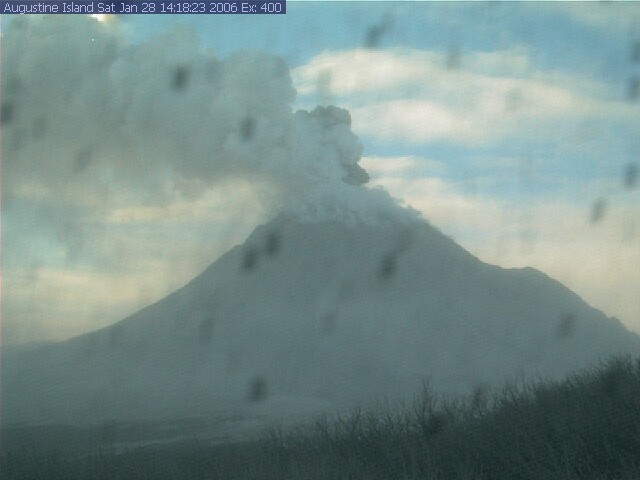 Dave at Bird TLC says the Augustine volcano has erupted 4 times in the past half-day after a couple of weeks of quiet time. This is the same volcano in the Cook Inlet about 280 km southwest of Anchorage [map] that's been fairly active since just before Christmas.
Dave at Bird TLC says the Augustine volcano has erupted 4 times in the past half-day after a couple of weeks of quiet time. This is the same volcano in the Cook Inlet about 280 km southwest of Anchorage [map] that's been fairly active since just before Christmas.
The Alaska Volcano Observatory has details and the Anchorage Daily News posts regular updates too. Check out the AVO webicorder data - nothing quiet about this island right now...
Friday cat blogging
Casper enjoys long walks with his dog and his peeps.
Technorati tag(s): friends & family
Plants as clocks
 In order to survive and reproduce successfully, many plant species have developed the ability to measure time. They need to measure or sense the time of day and the time of year in order to 'know' when to flower, when to germinate, when to produce seed, when to enter dormancy, etc. How do they accomplish this?
In order to survive and reproduce successfully, many plant species have developed the ability to measure time. They need to measure or sense the time of day and the time of year in order to 'know' when to flower, when to germinate, when to produce seed, when to enter dormancy, etc. How do they accomplish this?
Let's start with time of year measurement... temperatures are one way to detect time of year, or plants could sense day/night ratios. Ambient temperature is not a reliable indicator of time of year since it is highly variable and because no two years are identical. Instead, plants have adapted to use day/night length as an indication of time of year, because it's very consistent and so is a much more reliable index. The use of day length to measure time of year for the purpose of regulating physiological processes is knows as photoperiodism. Animals can also use photoperiodism, but that's another post. Researchers have figured out through a lot of experimentation, that plants are actually measuring the duration of darkness (or night), rather than duration of light (or day). They use a chemical called phytochrome which functions as a chemical clock or stopwatch. Phytochrome has two chemical forms - phytochrome far-red (Pfr) and phytochrome red (Pr). Phytochrome is usually, but not always, located in the leaves, so the leaves are responsible for doing most of the work of measuring photoperiod.
Phytochrome is a photoreceptor pigment that absorbs light energy. Pr absorbs red light energy (wavelength = 666 nm) and is chemically converted into Pfr. Pfr absorbs far-red light (wavelength = 730nm) and is converted into Pr. Since the sun produces both red and far-red light, there is constant two-way conversion between Pr and Pfr - an equilibrium develops. During light hours, conversion of one form to the other occurs rapidly - within milliseconds. Of the two, Pfr is the more biologically active form; it triggers plant responses to day length information. These reactions both require light energy. So, during darkness neither of these active reactions can occur.
 During the night however, Pfr very slowly and passively degrades to Pr in a process called dark reversion. On a summer morning there is typically a high Pr : Pfr ratio. By detecting morning levels of Pr and Pfr, the plant is essentially measuring how much time has passed during the night. When the level of Pfr reaches a critical point, physiological responses such as flowering or root growth might be triggered.
During the night however, Pfr very slowly and passively degrades to Pr in a process called dark reversion. On a summer morning there is typically a high Pr : Pfr ratio. By detecting morning levels of Pr and Pfr, the plant is essentially measuring how much time has passed during the night. When the level of Pfr reaches a critical point, physiological responses such as flowering or root growth might be triggered.
As the days lengthen and nights shorten (as in the spring), the amount of Pfr remaining in the morning increases from one day to the next and indicates to the plant what time of year it is. A second biochemical signal is then dispatched to communicate this day-lengthening information to various plant tissues to initiate floral development or seed production etc. The reverse situation occurs in the fall of the year - the amount of Pfr remaining in the morning decreases from one day to the next and indicates to the plant that days are shortening. Some plants, and some plant tissues, have adapted to respond to one or both seasonally important situations. So...in order to detect the time of year, plants must be able to tell the time of day, measure duration of night and compare it to the duration of night yesterday. Pretty complex, eh?
A short burst of light during an otherwise dark night disrupts the effect of the dark period because the flood of light converts Pr to Pfr to normal equilibrium levels within seconds, and the slow degradation from Pfr to Pr has to start all over again. The plant clock 'resets' when this occurs and night won't be detected until the next uninterrupted dark phase.
Plant 'clocks' detect some other diurnal and seasonal events for similar phenological purposes, but let's leave that for another cool plant tidbit post...
ADDENDUM: Coturnix has lots of biological rhythm and photoperiod-related info and stories as they occur in animal species.
Chauvinism declared a congenital defect
Here's a lovely sports-page news article from the testosterone- and camouflage-enhanced twits writing for the Mississippi Sun Herald. I just love it when they explain my feelings and behaviors for me! [via Twisty at I Blame the Patriarchy]:
Call of the wild: Women hear it, too
Dirty and wild: the new outdoor woman
[...]
Tens of thousands of ladies are fishing and hunting out there. They don't start with a lot of skill, but they learn quickly.
[...]
The main problem for many new women hunters is finding someone to show them what to do. They may know how to shoot a rifle or shotgun, but that doesn't mean they know where to place their tree stand or how to call a turkey.
Give them a chance. If you meet a woman in camo, be friendly and ask if she needs help. Dragging a 180-pound buck out of the woods is hard, doing it when the buck weighs almost twice as much as the hunter is almost impossible.
So share your knowledge and strength; there's plenty of room in the woods and on the water for us all.
Yikes! Twisty views the article as "sublimely patronizing" and adds to the authors summation "and consider not raping her." Yeah, you can offer your help, but only because you'd offer it to your male co-conspirators too, Jim Bowie. I don't know, I cringe from the possibility of sounding harsh because I know how it's heard, but if I can actually smell the chauvinism... then it's really bad. Is it possible to view the other people in the woods or water as equals? Independent of gender? Because we are you know. Take an unbiased look around. These are just a few who blog. I've learned some really great outdoorsy stuff from men. But, I've learned equally cool outdoorsy stuff from women. In both cases, I learned from them because they were knowledgeable and able to teach, not because they were male. Some men are incredibly adept at hunting, fishing, trapping, cooking; and others should stay home where they're safe from heavy or pointy things, strange shadows and loud noises. Men can be counted on to shoot each other in the woods every fall. The same principle applies to women however. We are not automatically skilled or unskilled at anything by virtue of our gender.
I say this as an 'outdoors woman' who has applied her 'knowledge and strength' to save 'outdoors men' from certain ignorance, inconvenience and/or demise a time or two. So have some of my women friends. Two close female backpacker friends of mine rescued a male hiker with an ankle injury while traversing Isle Royale a couple years back. They found him, fed him, splinted his ankle and hopped him to a ranger station. B and I have helped out 'outdoors men' a few times too. A couple of winters ago, B and I were wading and fishing a gorgeous stretch of the Pere Marquette River on New Year's Day. It was a beautiful cold and snowy day, the trees and banks were blanketed with several inches of new snow, and we had the river to ourselves - almost. During our wonderful, peaceful outing, we were occasionally passed by the one boat that was out fishing the same stretch that day. B and I, and the 2 men in the driftboat, chatted and exchanged pleasantries several times while we all leap-frogged each other downstream during the glorious afternoon. They were genuinely friendly 'outdoors men.' We were all enjoying the peaceful river.
When the purpley-gray dusk rolled in, the men beached their boat down at the ramp and we waded out and hiked toward the car - the only car in the parking area. We quickly noticed a change in the tone of the male voices we'd scarcely been aware of. One man had hiked up from the ramp to fetch his truck and trailer only to discover that it wasn't there. They had apparently hired someone to deliver their truck and trailer from their put-in spot to this take-out location, and something had gone awry. So here we were, 2 women, 2 friendly but essentially unknown men, one smallish car packed full of fishing/vacationing gear and a driftboat. It was at least 2 miles back to town, so there was no way we were just leaving them there to fend for themselves in the cold and darkness. They had no phone and didn't think they would find an easy solution late on New Year's Day - the flyshops and businesses were all closed and they didn't even know if they'd find anyone at home to help. Our packed-to-the-gills car was capable of transporting only 2 people, so I quickly calculated that B would have to drive one of the men to town to call/fetch/resolve something and I'd have to stay here in the dark with the other guy until they returned. They seemed like good guys, but why should I trust my intuition? A brutal attack on a woman had happened several years before on this very river. That was an altogether different situation I think, but how do you ever know in advance? You don't but I figured I'd have to trust my instincts and take calculated risks like this occasionally to help others out. B's cell phone was dead and mine could receive no signal. B proposed driving one man to town with her while I and the other stranded fisherman waited at the boat ramp. "I'll take one of these guys to town to find some help - if you're OK staying." "Um, ... yeah, I guess I'm OK with that. Just let me grab my warmest jacket." Man #1 noticed my slight hesitation and assured me that I shouldn't be scared. Before I could muster a response, he followed with, "Don't worry, he'll take care of you," pointing his thumb toward his buddy. Uh, .....OK. ....Right. I quickly figured out that he assumed my safety concern must be about a third, as yet unidentified mugger/murderer/rapist/gunman waiting in the woods to pounce at the first opportunity. Wow. Talk about a clash of cultures. I think he'd never in a million years figure out that someone might be concerned about him. And why is he so confident that a smallish, unarmed fisherman would protect anyone against this unknown assailant?
B drove into town with man #1 while I stood around in the darkness with the man #2. From a respectable distance, we chatted about all things fishing, then about all things lower Michigan, and then about all things fishing again. B was gone for at least 45 minutes with man #1. When B finally returned, she reported that they'd finally found a friend or a neighbor at home and the friend was now on his way to join these 2 guys at the boat ramp. With everyone satisfied that transportation was on the way, we bid the men farewell and happy new year and started our long drive home. B and I had a lot to talk and laugh about during our drive. While I don't think this is the type of outdoor assistance the Mississippi writer was imagining, a bad situation is a bad situation and help is help. It's really the same thing. Ours had been a slightly inconvenient and humorous situation that ended well, but mainly we were amazed and a little shocked at how some men apparently see themselves and at how differently we all perceived our little situation.
Moral of the story: Gender schmender. Start by assuming others are your equals and go from there. Dude, it might be an 'outdoors' woman that comes to your aid some day.
Technorati tag(s): fishing, liberal politics
No more 'real' questions (even from 'fake' audiences) for awhile I bet...
I want to send out a big smooch to the K-State student who asked Tush a question at yesterday's Make a Mockery of Democracy/Defense of the "Terrorist Surveillance Program" Session staged by the Whitehouse at Kansas State University. The Whitehouse promoted the 'public' session in advance by stating that Tush would be fielding unscripted audience questions for a change. Imagine that. Their plan to display the implied power and competence of their dear leader backfired a bit.
Here's the Yahoo news story:
Bush Hesitates to Give Take on 'Brokeback'
MANHATTAN, Kan. - Asked his opinion of the movie "Brokeback Mountain," President Bush hemmed and hawed.
"You would love it. You should check it out," a man in the audience told Bush Monday during a question and answer session at Kansas State University.
After some hesitation — and laughter in the audience — Bush said, "I'd be glad to talk about ranching, but I haven't seen the movie." The audience laughed some more, and Bush, who owns a ranch in Texas, allowed that, "I've heard about it."
I happened to hear Don Gonyea's report on NPR last night:
Don Gonyea, NPR All Things Considered on 1/23/2006 from Manhattan KS:
[...]
DG: "As often happens when the president takes questions from the public, there are things that come out of the blue. Today, an audience member noted that Kansas has a lot of ranchers and that the president is a rancher himself. He wondered if Mr. Bush has seen the hit film Brokeback Mountain which features the story of two male ranch hands who meet and fall in love in a story set in the 1960s."
Student: "Ah, you’re a rancher; a lot of us here in Kansas are ranchers. Ah, I was just wanting to get your opinion on Brokeback Mountain, if you’d seen it yet." [Audience roars] "You would love it. You should check it out."
Bush: "I haven’t seen it."
DG: "It seemed an uncomfortable moment for the president who moved on to the next question then begged off explaining that he had to get back to the Whitehouse for dinner with outgoing Fed Chariman Alan Greenspan."
Though the audience was another handpicked, screened assembly of students and Kansas loyals, at least one left- or center-leaning man made his way into the auditorium. Thank you thank you thank you. I know I'm not the only American who is peeved about this whole screened audience, scripted questions approach the Whitehouse uses to manipulate public perceptions of their criminal and inept governance. Town halls are public places. If you're going to insist that it's a 'Town Hall' meeting, public access and participation ought to remain open. Otherwise it's just another lie.
UPDATE: Dan Froomkin has a review of Tush, Live at K-State.
Technorati tag(s): liberal politics, GLBT
'Secret Creek' fishing report [22 Jan 2006]
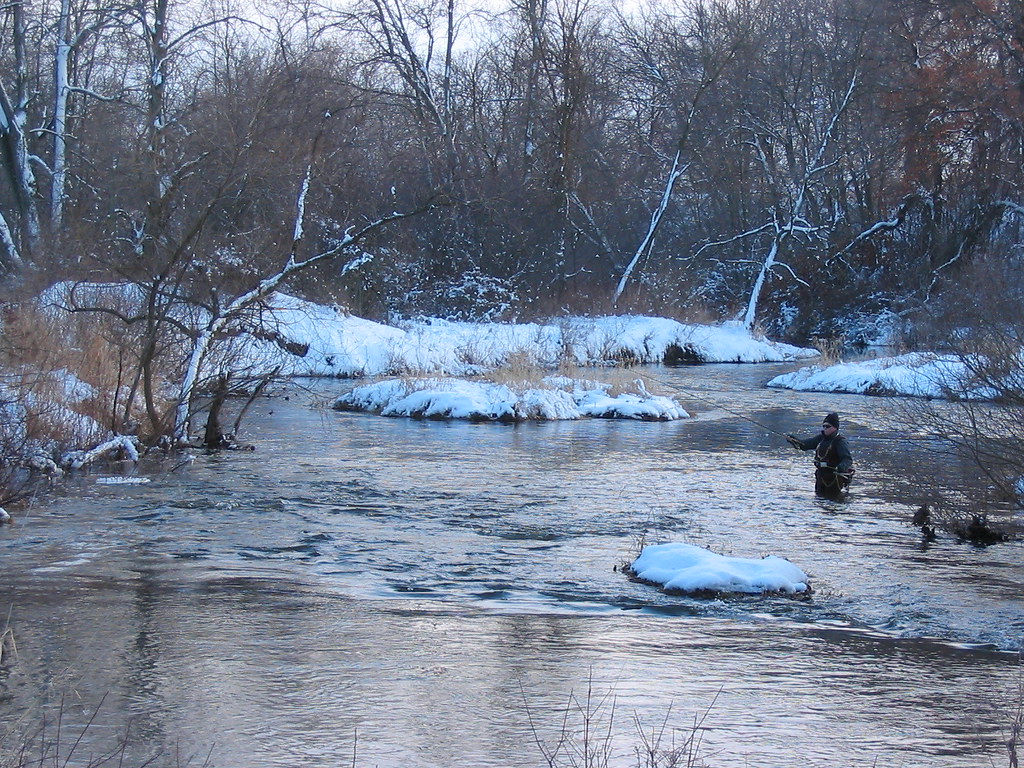 It's been a long 3 weeks since our last fishing outing. While 3 weeks is a long time, we typically don't get out much during the month of January at all - normal Michigan temperatures are a tad cold for outdoor activities that require liquid water. This year though, January has been abnormally warm and extra conducive to winter steelhead and trout fishing - we just haven't taken full advantage. So we felt a bit lucky today to have a chance to head for a small nearby stream that remains open to fishing year-round, has marginal trout populations but has good runs of steelhead and salmon.
It's been a long 3 weeks since our last fishing outing. While 3 weeks is a long time, we typically don't get out much during the month of January at all - normal Michigan temperatures are a tad cold for outdoor activities that require liquid water. This year though, January has been abnormally warm and extra conducive to winter steelhead and trout fishing - we just haven't taken full advantage. So we felt a bit lucky today to have a chance to head for a small nearby stream that remains open to fishing year-round, has marginal trout populations but has good runs of steelhead and salmon.
Several inches of new, untouched snow blanketed the riverbanks and the surrounding landscape. Our area received about 6 inches of snow in one quick storm on Friday night after several weeks of warm, above freezing temperatures. So this crisp, new, sparkly snow looked a little extra beautiful today. The air temperature was a comfortable 40 oF or so, and we enjoyed a recently-rare, partly-sunny sky. Water levels appeared to be about average for this time of year but the water color was a bit stained.
'Secret Creek' is a small tributary to a large river and it receives pretty heavy fishing pressure during the fall salmon migration for such a small waterway. It's a small, gravel- and boulder-bottomed stream, averaging 20-30 feet across and 1 to 3 feet deep. During the winter, angler traffic is normally almost non-existent. So when we arrived at about 1:30 this afternoon, we were surprised to see 3 fishermen in orange and camo leaving the stream at our chosen access. They had been drifting spawn and reported catching a few trout, but no steelhead.
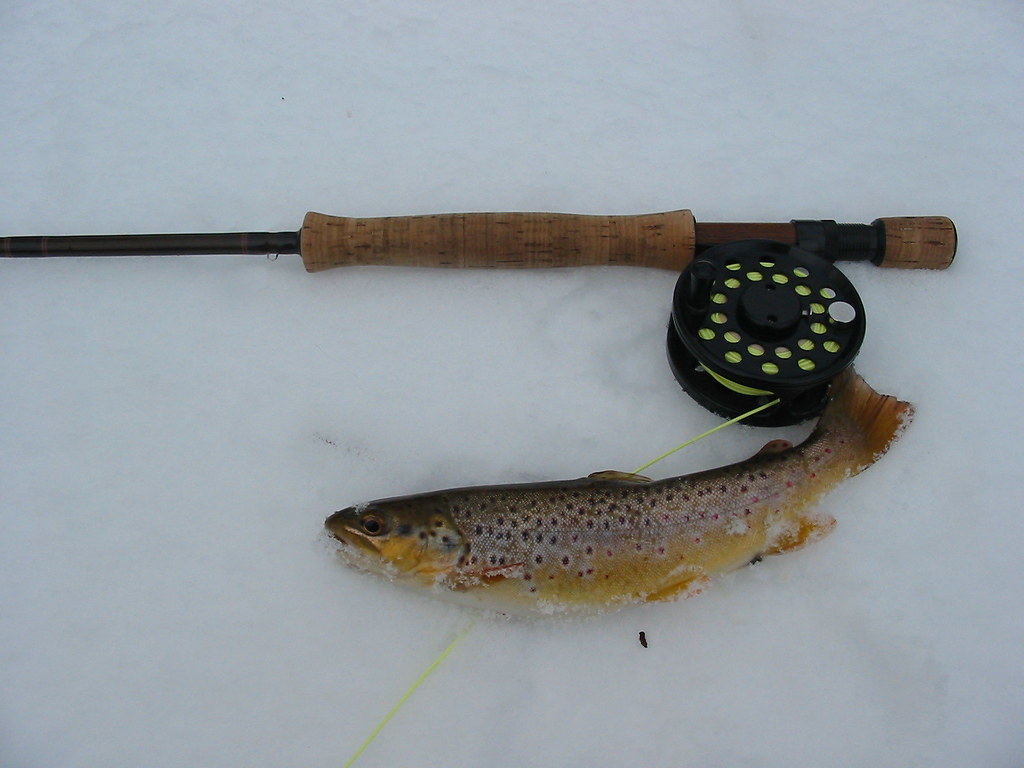 We squeezed our fleece-clad selves into waders, rigged up our favorite steelhead fly rods and waded upstream. The footpath along the bank had very few footprints - probably just the 3 outgoing fishermen had been on the river since Friday. It's always nice to think you may be fishing to un-harassed fish. We hiked up to the first nice, likely steelhead-holding hole and began drifting yarn eggs and nymphs under a bobber. I started in the hole where B caught a really nice winter steelie a couple of years ago. I'd fished the hole first that day too. I had probably made 50 drifts through the short, narrow hole - hitting all the good seams, or so I thought. B came along and I offered it to her. She took the chance and also wanted to try out my rod. About 10 casts later, she hooked a nice male steelhead. After a short battle, I plunged my arms, and the sleeves of my pullover, into the 33 oF water to land the big fish, and B snapped a photo. She had caught the big steelie in my hole, with my rod, on my fly, and I froze my arms - but I got to hold the fish for the picture. Today, this hole yielded no steelhead, but I did catch a nice, colorful, 12" brown trout. I snapped a quick photo and returned him to the cold water.
We squeezed our fleece-clad selves into waders, rigged up our favorite steelhead fly rods and waded upstream. The footpath along the bank had very few footprints - probably just the 3 outgoing fishermen had been on the river since Friday. It's always nice to think you may be fishing to un-harassed fish. We hiked up to the first nice, likely steelhead-holding hole and began drifting yarn eggs and nymphs under a bobber. I started in the hole where B caught a really nice winter steelie a couple of years ago. I'd fished the hole first that day too. I had probably made 50 drifts through the short, narrow hole - hitting all the good seams, or so I thought. B came along and I offered it to her. She took the chance and also wanted to try out my rod. About 10 casts later, she hooked a nice male steelhead. After a short battle, I plunged my arms, and the sleeves of my pullover, into the 33 oF water to land the big fish, and B snapped a photo. She had caught the big steelie in my hole, with my rod, on my fly, and I froze my arms - but I got to hold the fish for the picture. Today, this hole yielded no steelhead, but I did catch a nice, colorful, 12" brown trout. I snapped a quick photo and returned him to the cold water.
 We fished our way upstream through 5 or 6 more good steelhead holes. Someone caught a big fish of some kind - probably a steelie - in one of them. I noticed wide drag mark through the snow. If not the 3 guys before us, then someone before them. We managed to catch 3 more trout between us - all browns. We didn't hook any steelies, though we were both quite confident we'd fished over some. As I fished the upstream-most hole before we headed back down, I noticed that my rod guides had begun to freeze up. I was standing in the shade of a high bank and the sun had set behind it. Without direct sunlight, the air temperature had dropped enough to necessitate knocking the ice off my rod every 15 minutes or so.
We fished our way upstream through 5 or 6 more good steelhead holes. Someone caught a big fish of some kind - probably a steelie - in one of them. I noticed wide drag mark through the snow. If not the 3 guys before us, then someone before them. We managed to catch 3 more trout between us - all browns. We didn't hook any steelies, though we were both quite confident we'd fished over some. As I fished the upstream-most hole before we headed back down, I noticed that my rod guides had begun to freeze up. I was standing in the shade of a high bank and the sun had set behind it. Without direct sunlight, the air temperature had dropped enough to necessitate knocking the ice off my rod every 15 minutes or so.
The day was noticeably longer compared to the last day we spent standing in a river. We fished our way back downstream, drifting through all the same holes and a couple more. It was about 6:00 when we reached our bridge and hiked out and onto the road. We chipped the ice off one last time, packed our rods away and headed home.
Stats
Fleece quotient: 1 mid + 1 heavy
Lost flies: 0!
Spills, mishaps, slip-and-fall accidents: 0!
Wildlife sightings: A flock of 15-20 cedar waxwings; downy, hairy and red-bellied woodpeckers; squirrels; a kestrel
Air temperature: 30-40 oF
Water temperature: 34-36 oF
Did I get to use a spey rod?: Yep, my little one.
Enjoyment grade for the day: A
Technorati tag(s): fishing report, fly fishing, nature
Earth to Rene Portland and Penn State....
I missed my chance a couple weeks ago to don a lavender t-shirt and hang out with my peeps at the recent Michigan State vs. Penn State women's basketball game here in East Lansing, but here's a very nice piece (by a local blogger!) about what I missed:
Portland supporters have a history of marginalizing protesters; ignoring the protests and calling activists “non-existent”. It’s safe to say that the East Lansing LGBT community wasn’t so easily dismissed. In addition to The State News and Pridesource.com, the event generated mainstream media coverage through WLNS channel 6, WILX channel 10, and the Lansing State Journal. One Lansing resident created awareness of the issue by working her way through the stands wearing signs that read “shameless bigot” and “fire me”. “I think that our presence was definitely noticed by other fans, and both teams“, said Megan Gallagher, one of the organizers.
The fans and the two teams weren’t the only ones who were paying attention. Campus Police and East Lansing Police Department assigned extra officers to work the game, and the band and student seating in the arena was reversed. A last minute change put the Penn State bench as far away from the student section as possible. For the first time this season, Breslin Student Event Center Security conducted random physical searches of spectators, and Coach Portland received an escort when she traveled between the locker room and the bench.
The Rene Portland imposter in the blonde wig and 'bigot' sign looks eerily familar to me. Did we play soccer together somewhere in the past?
Technorati tag(s): GLBT, liberal politics
I and the Bird #15
 Aydin at Snails Tales has continued the literary theme with the current edition of I and the Bird blog carnival. He's fashioned the list of bird-oriented links into a Bob Dylan-inspired poem. All the usual suspects, plus a few new ones, are included. Enjoy!
Aydin at Snails Tales has continued the literary theme with the current edition of I and the Bird blog carnival. He's fashioned the list of bird-oriented links into a Bob Dylan-inspired poem. All the usual suspects, plus a few new ones, are included. Enjoy!
Technorati tag(s): blog carnivals, blogs & links
E.O. Wilson on ID
Dr. E.O. Wilson is a wonderfully accomplished scientist and writer. An entomologist by training, he's most known for his popular books on ecology and biodiversity and our human interactions with nature. He's one of our best scientific voices. He's won Pulitzer Prizes and other prestigious awards for his contributions to our expanding pool of scientific understanding. Here's what he recently wrote about science v. intelligent design in a short article entitled 'Let's Accept the Fault Line Between Faith and Science':
In the explanation of evolution, and especially of the human mind, might intelligent design provide a compromise between biology and religion? This now-famous proposal asserts that evolution is real but guided by a supernatural intelligence. The evidence, however, consists solely of a default argument followed by a non sequitur. Its logic is this: Biologists have not explained how some complex systems, such as the human eye and brain, could have evolved by random mutations and natural selection. More important, proponents say such an explanation is impossible. Therefore, they claim, a higher intelligence must have guided evolution.
Unfortunately, no positive evidence exists for such a claim. No scientific theory has been proffered or even imagined to explain the transcription from a supernatural force to organic reality. This absence of the elementary requirements of science is why intelligent design is better taught as religion or science fiction. Thankfully, educators and administrators -- including most recently those in Dover, Pa. -- are arriving at a similar conclusion.
[via Paleoblog]
Tangled Bank #45, on sale now...
![]() ...over at GreyThumb.blog.
...over at GreyThumb.blog.
The site seemed to load slowly for me, but be patient, it's worth it. Mike from 10,000 Birds, Nuthatch, Chris Clarke, Aunt Twisty, yours truly and lots of geeky regulars have something to share in this episode.
Technorati tag(s): science, evolution, blog carnivals
Volcano activity near Anchorage
 Dave from Bird TLC reports that the Augstine Volcano, on Augustine Island in the Cook Inlet about 280 km southwest of Anchorage [map], has been spewing ash and smoke and a little lava for the past few days. Apparently, these eight "explosive events" have been enough to throw ash 52,000 feet into the air resulting in cancelled airline flights into Anchorage and "a buying frenzy of dust mask, tarps, visqueen and vehicle air filters."
Dave from Bird TLC reports that the Augstine Volcano, on Augustine Island in the Cook Inlet about 280 km southwest of Anchorage [map], has been spewing ash and smoke and a little lava for the past few days. Apparently, these eight "explosive events" have been enough to throw ash 52,000 feet into the air resulting in cancelled airline flights into Anchorage and "a buying frenzy of dust mask, tarps, visqueen and vehicle air filters."
The Anchorage Daily News initially reported expectations of a major eruption, then in the last few days predictions have been downgraded to 'not likely' because time between eruption events had lengthened. At 8:00 AKST this morning however, the assessment is much more serious:
Seismicity at Augustine Volcano has increased markedly in the last hour. Based on these measurements, we believe that an explosive eruption has become more likely and could occur without further warning.
 This morning's seismic data shows perhaps why the geologists are concerned. Scroll to the bottom of the recording and you'll notice a dramatic increase in intensity of signals. They've now upgraded the volcano status to RED indicating that a serious eruption is occurring or explosive eruption is expected at any time.
This morning's seismic data shows perhaps why the geologists are concerned. Scroll to the bottom of the recording and you'll notice a dramatic increase in intensity of signals. They've now upgraded the volcano status to RED indicating that a serious eruption is occurring or explosive eruption is expected at any time.
It appears that the recent bout of Augstine activity started just before Christmas, but became more intense Thursday and Friday of last week. Augustine last erupted seriously in 1986. The Alaska Volcano Observatory has details and a live webcam. Television news channel KTUU has a fly-by video of some steam and ash spewage.
We'll keep our fingers crossed Dave...
UPDATE: Another eruption at 7:58 AKST this morning similar in energy to last week's - It lasted 5 minutes. National Weather Service issued an ash fall advisory for the Kenai Penninsula. I won't be complaining about our cloudy weather here in Michigan anymore...
A canary in a coal mine?
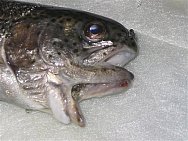 Amphibians are notoriously sensitive to environmental contaminants and are often the proverbial 'canaries in the coal mine,' indicating problematic levels of toxins. Amphibians have also been recently highlighted as a potential sentinel for disease epidemics resulting from global warming. (Nuthatch has written more on this particular topic.) Frogs, salamanders and others in this family of vertebrates, take in oxygen and water through the skin and therefore can increase concentrations of pollutants to toxic levels more quickly and irreversibly than most other species. In fact, worldwide amphibian populations are decreasing, and environmental toxins are thought to be one potential cause.
Amphibians are notoriously sensitive to environmental contaminants and are often the proverbial 'canaries in the coal mine,' indicating problematic levels of toxins. Amphibians have also been recently highlighted as a potential sentinel for disease epidemics resulting from global warming. (Nuthatch has written more on this particular topic.) Frogs, salamanders and others in this family of vertebrates, take in oxygen and water through the skin and therefore can increase concentrations of pollutants to toxic levels more quickly and irreversibly than most other species. In fact, worldwide amphibian populations are decreasing, and environmental toxins are thought to be one potential cause.
I'm not sure where salmonids fit into the overall hierarchy of environmental sensitivity, but perhaps this rainbow trout indicates that somebody in Nebraska ought to look into it...
[via Shoutfish]
Bedtime for turkeys
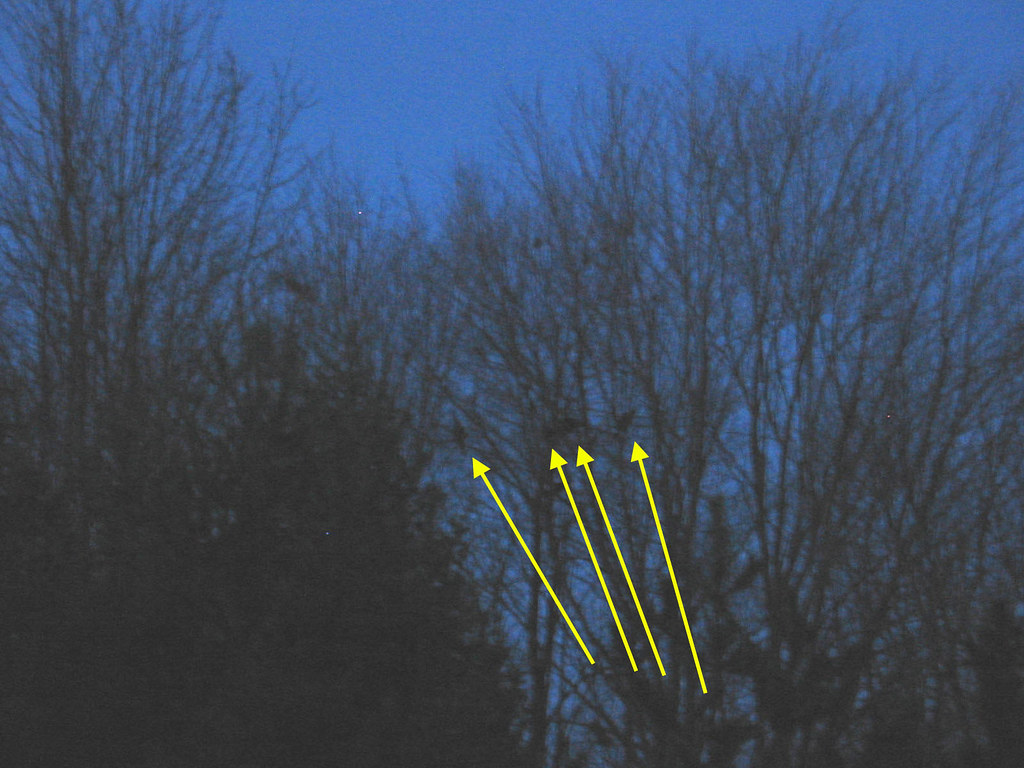 For the past few weeks, we've been noticing that our most local small flock of Wild Turkeys (Meleagris gallopavo) are as reliable as clockwork. Every evening at 5:00, if we're home, we hear the loud crashing of turkey wings beating through tree branches as the turkeys begin their nightly roosting routine.
For the past few weeks, we've been noticing that our most local small flock of Wild Turkeys (Meleagris gallopavo) are as reliable as clockwork. Every evening at 5:00, if we're home, we hear the loud crashing of turkey wings beating through tree branches as the turkeys begin their nightly roosting routine.
Our little flock of 12 or 15 turkeys has chosen a small stand of mature hardwood trees in a low, wet area that is surrounded by a much larger stand of white pines and open grassland. The first few times we heard this series of loud, irregular and abrupt sounds, we weren't sure what we were hearing. Deer crashing antlers on small trees? Nope, this is much louder than that. Some other large animal breaking through suspended ice? Maybe... Finally, we stood still long enough to make out the sounds of big wingbeats over the sounds of tree branch impacts and figured it out. Also, if we stand in just the right spot, they become visible as the work their way up higher and higher until they're probably 20-30 feet off the ground. [Sorry for the poor picture, dusk is not the best time of day for low-end digital photography.]
We've been entertained by the almost-comical sights and sounds of wild turkey roosting before, but never right here in our backyard - until this winter. On one particular stretch of trout stream on the west side of the state, we share the company of a small band of turkeys almost everytime we fish there. And we've often stood, fly rod still, watching them with smiles on our faces in slight disbelief at the clumsy awkwardness and sheer racket of their nightly process.
On the ground, wild turkeys are large, powerful, elegant birds, but it's difficult to appreciate these features while watching them jump, flapping and flailing awkwardly, grabbing branches and smashing through the canopy to their nightly roosting places.
Climate change v. the rosebushes
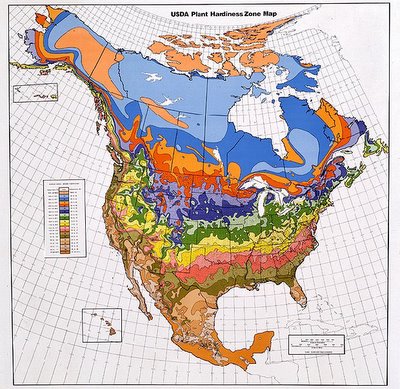 Chris Clarke, at Creek Running North, has written a really good post about some of the practical implications of climate change.
Chris Clarke, at Creek Running North, has written a really good post about some of the practical implications of climate change.
Rather than writing persuasively in order to convince skeptics about the reality of global warming and climate change, many scientists and scientific writers have moved on to the important work of figuring out how we'll need to adapt our lives and strategies to suit our new and changing climate. Chris has written about how the USDA Plant Hardiness Zone maps have been altered to reflect changing temperature extremes across North America. The Hardiness Zone map was first published in 1990 and was intended as a tool to guide selection and management of plants over the range of temperatures encountered in the North America. The map was modified in 2004 to reflect the new temperature extremes resulting from climate change. Chris has side-by-side maps for comparison. About half the US has shifted up one zone. A few spots have shifted 2 zones. The portions of the country without a zone change have also warmed, but not enough to warrant a zone change yet.
Here in lower Michigan, we're no longer considered zone 5, but we've warmed ourselves up to zone 6. In just 14 years. A small change that will have huge effects to both natural and artificial plant and animal systems.
Mike Rogers power grab
Several news outlets are reporting today that Congressman Mike Rogers (R-8th), is throwing his hat into the race for Majority Whip in the US House of Representatives. House leadership is in a state of change since Tom Delay, ex-Majority Leader, has fallen out of favor with his recent indictments for money laundering and conspiracy. The Majority Leader position is likely to be filled by either Roy Blunt (R-MO) or John Boehner (R-OH). Majority Whip would be the 2nd in command behind Majority Leader. Rogers is not expected to win the seat.
Rogers is paying a lot of empty lip service to the recent wave of GOP scandals in his Whip candidacy announcements to the media in an attempt to set himself apart from the rest of the party:
I think Rogers' implicit accusations are crap and that any Repugnican wishing to lend credibility to this sort of assault should begin by naming the problem a bit more accurately. Lobbying and Indian gaming money are not the reasons Delay has been whisked away to the attic. Rather, Delay himself is the reason Delay is in trouble. There are no bribes unless someone takes the cash and follows through on the underhanded deal. I prefer Josh Marshall's assessment:"I am afraid we have lost our way in the day-to-day administration of this government," Rogers wrote. "Bold change is a must if we are going to regain the public's trust and confidence."
Rogers called for several changes, including creating an independent commission to audit lobbyists' activities and revising campaign finance laws to ban Indian tribes from spending unlimited money on congressional elections.
Lobbying and Indian gaming money are two major reasons that the whip job may be up for grabs.
When you want to clean up the neighborhood, there's generally very little you can accomplish until you get the actual criminals off the streets. Once that's done, you can knock down the abandoned buildings, reseed the park, refound the neighborhood watch organization, whatever.
But the true, immediate and overriding problem with a crime-infested neighborhood is the criminals.
Congress, and thus the country, faces a similar predicament.
Congressman Rogers, if you really aim to clean up this problem and create change, start by returning the $20,000+ you've received from Tom Delay and 'Duke' Cunningham.
ADDENDUM: Matt from Michigan Liberal has much more on this. He says:
Read on.[...] ...contrary to what you have been told, Rep. Rogers is NOT an outsider. In fact he's the farthest thing from it. [...]
Technorati tag(s): liberal politics
Bile farm bears in paradise
"All the world's a stage
And all the men and women merely players;
They have their exits and their entrances,
And one man in his time plays many parts,..."
So goes this famous soliloquy in Shakespeare's As You Like It. Shakespeare, through his character Jacques, compares life to a play, where each actor contributes toward the overall success or failure of the larger work through his/her individual performance. Subsequent philosophers have furthered this concept by theorizing that the most any individual can accomplish in life is to positively influence our nearest neighbors and fellow 'actors' in the play that is life. This is a philosophy that makes sense to me. I think it's also a theme for my friend Kati.
Kati is a friend and fellow 'actor' within my local part of the big 'play.' She's currently a veterinarian in China working with Animals Asia Foundation. Kati and other dedicated folks work diligently every day to rescue and rehabilitate bears that have been cruelly used for 'bile farming' in Asia. I've known Kati since my first stint in grad school while she attended vet school here in Michigan. After working in a veterinary practice for a time, she returned to school for a PhD and then went on to work on environmental toxicology research topics at the University of Wisconsin and the Smithsonian Institution before finding her place among the bears at AAF in China. She's always wanted to work with bears and I'm happy she's found a way to apply her enormous volume of knowledge and compassion with them, though I know this must be very difficult work.
I've written about Kati and her bears before. This week, she's sent a few photos of 'Banjo,' a darling, fun-loving young male bear who is a victim of the "free-dripping" method of bile collection. Before his rescue, he suffered a crude surgery to create a permanent hole in his abdomen, from which bile was drained. Banjo is lucky to be alive as other bears have tragically died as a result of this treatment. Today, Banjo is healthy and happy, living in bear paradise with his play buddy, 'Jasper.' Click the photos below for a larger view. Banjo is a handsome Asiatic black bear. In the photos, Banjo's the bear with no 'eyebrows.'
I'm grateful that my fellow 'actors' are able to provide such essential services as these. And I'm grateful that the internet(s) now allow our 'sphere of influence' to reach around the planet and stay in touch. Thanks Kati.
Technorati tag(s): friends & family, science
Rather interesting search strings
I occasionally like to peruse the list of search strings that led recent surfers to this blog. There are often some rather interesting entries. Here are some recent ones that caught my attention:
- hilarious sarcasm
- pickling blue gills
- what is hard water and how did it get its name
- birdist
- scott 9'9" 6wt fly rod
- steelhead fishing on the pere marquette
- nuthatch paintings
- anything of value
- on behalf of president bush, thank you for your correspondence
Technorati tag(s): blogs & links
I and athe Bird #14
 Gwyn, over at Bird Brained Stories!, is quite a storyteller and is currently hosting the I and the Bird blog carnival. She has assembled birdy posts from around the blogosphere into an above-average, Garrison Keillor-inspired collection called 'Lake Birdbegon Days.' Enjoy!
Gwyn, over at Bird Brained Stories!, is quite a storyteller and is currently hosting the I and the Bird blog carnival. She has assembled birdy posts from around the blogosphere into an above-average, Garrison Keillor-inspired collection called 'Lake Birdbegon Days.' Enjoy!
Technorati tag(s): blog carnivals, blogs & links
People are starting to sound a bit depressed...
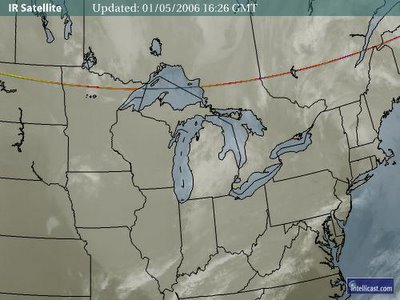 If your friends, coworkers and fellow townspeople are at all like mine here in the upper Midwest, then you've been hearing a lot of depressed and dismal talk lately about the cloudy, overcast, gloomy weather we've been enduring for the past month and a half. The type of cloudiness has varied from a high, heavy blanket of grey to a low, misty haziness. Inuits are supposed to have 20 different words for 'snow'; perhaps we need 20 different words for 'cloudy'. Everyone seems to be ready for a few days of sunshine to lift their spirits. One of my coworkers remarked today that her little 3-year old daughter has asked "Mama, is it day?" several times during the past week in the middle of the afternoon.
If your friends, coworkers and fellow townspeople are at all like mine here in the upper Midwest, then you've been hearing a lot of depressed and dismal talk lately about the cloudy, overcast, gloomy weather we've been enduring for the past month and a half. The type of cloudiness has varied from a high, heavy blanket of grey to a low, misty haziness. Inuits are supposed to have 20 different words for 'snow'; perhaps we need 20 different words for 'cloudy'. Everyone seems to be ready for a few days of sunshine to lift their spirits. One of my coworkers remarked today that her little 3-year old daughter has asked "Mama, is it day?" several times during the past week in the middle of the afternoon.
In Michigan's Upper Penninsula, it's common for folks to consider taking prescribed light treatments to combat Seasonal Affective Disorder or just general winter blues when the long dreary winter becomes too much to bear. I bet the light booths are fully booked this season. Some people seem to be more susceptible than others to this sort of season- and weather-induced depression, but it's pretty much a universally accepted medical condition and I'd bet more folks than average are affected in Michigan this winter. It's been atypically warm and cloudy.
It seems that many of my fellow Michiganders are also under the impression that, wherever we live here in Michigan, it's the "second most cloudy city in the country" or some similarly extremely cloudy place relative to the rest of the US. I hear that generalization a lot here, and I also heard it just as frequently from residents of Ithaca, NY when I lived there. We seem to be comfortable assuming that somewhere in the Pacific Northwest lies the cloudiest city, but 'here' is a close second. Wherever 'here' is.
I decided to find some cold, hard data on the frequency of cloudy days and put this subject to rest in an objective manner. The National Oceanic & Atmospheric Administration (NOAA) keeps track of just this sort of thing. I found a list of historical mean cloudy days per month and per year for almost 300 cities within the United States and its territories. The means are based on 30 to 50 years of weather observations for each city. I perused the data and decided to throw out the data for about 40 cities for which the sum of clear, partly cloudy and cloudy days did not equal 365 days per year +/- 2 days. I ranked the remaining 269 cities in order of increasing number of clear days per year. I graphed the results for a subset of recognizable cities I thought might be of interest to the readers of this blog. (Sorry Canadians... I didn't access Canadian weather data!)
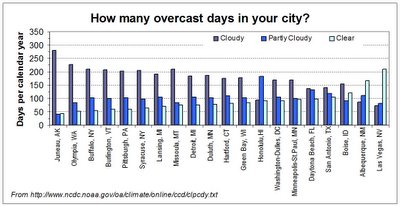 (Click the graph to enlarge it and make the x-axis significantly more legible.) The graph shows the mean number of days per category of cloudiness for a subset of cities I chose from the list of 269. The cloud cover categorization was determined for daylight hours only. 'Clear' denotes zero to 30% average sky cover, 'partly cloudy' denotes 40 to 70% average sky cover, and 'cloudy' denotes 80 to 100% average sky cover. According to this data, cities surrounded by ocean, such as those located on islands in the Pacific Ocean, appear to be the cloudiest. The cities of Chuuk, Pohnpei and Yap in the Caroline and Marshall Islands top the list with an average of about 300 cloudy days per year. The first sizeable, recognizable city in this list is Juneau, Alaska with 280 cloudy days per year. Lansing and Detroit, Michigan - closest to my location - are almost halfway down the graphed subset with 191 and 185 cloudy days respectively. This is a long way from the 'second most cloudy city in the country' status, but at the same time, 190 cloudy days per year is a lot. The least cloudy cities in the list are Las Vegas, NV and Yuma, AZ averaging only 73 and 52 cloudy days per year. No cities averaged less than 52 cloudy days.
(Click the graph to enlarge it and make the x-axis significantly more legible.) The graph shows the mean number of days per category of cloudiness for a subset of cities I chose from the list of 269. The cloud cover categorization was determined for daylight hours only. 'Clear' denotes zero to 30% average sky cover, 'partly cloudy' denotes 40 to 70% average sky cover, and 'cloudy' denotes 80 to 100% average sky cover. According to this data, cities surrounded by ocean, such as those located on islands in the Pacific Ocean, appear to be the cloudiest. The cities of Chuuk, Pohnpei and Yap in the Caroline and Marshall Islands top the list with an average of about 300 cloudy days per year. The first sizeable, recognizable city in this list is Juneau, Alaska with 280 cloudy days per year. Lansing and Detroit, Michigan - closest to my location - are almost halfway down the graphed subset with 191 and 185 cloudy days respectively. This is a long way from the 'second most cloudy city in the country' status, but at the same time, 190 cloudy days per year is a lot. The least cloudy cities in the list are Las Vegas, NV and Yuma, AZ averaging only 73 and 52 cloudy days per year. No cities averaged less than 52 cloudy days.
A bright sunny, clear day sounds really really wonderful. Though it's been dismal enough that I'd gladly take a day of only 80% cloudy. That'd be an improvement.
UPDATE: I should express my fantasies on this blog more often I guess. I'm gazing at about 80% cloud cover today, but I can see actual blue through the holes in the fluffy, white, swiss cheese clouds. And as I type this, I'm enjoying having to occasionally squint through the glare off my computer screen. I do not have the same view of the glare during nicer weather. Sharp, distinct shadows, lasting about 10 seconds, appear every little while. It's colder, overnight temperatures dropped to 19 oF (-7 oC). Things are looking up!
Tangled Bank #44 is hot off the presses
![]() ...over at Afarensis.
...over at Afarensis.
And PZ says the Dover, PA school board has now officially rescinded their policy of teaching creationism in science classes. Yay.
Rogue River fishing report [2 January 2006]
 B and I enjoyed our last day of Christmas/New Year vacation fishing for steelhead on the Rogue River (MI). We took our friend D along with us. D's not a serious fisherperson (yet), but for some reason, she's been dying to get out with us to stand in a cold river waving a rod. We helped her choose her wardrobe and equipped her with a nice rod and reel and decided to fish the same favorite stretch of the Rogue we've been fishing this winter. The weather was kind of crappy by normal outdoorsperson's standards, but we hoped the warmish (43 oF), overcast, misty, rainy conditions might align for optimum steelhead possibilities. Then again, we've been interpreting a lot of weather conditions this way lately and we're batting 0.000%. At least we figured we might not have to compete with too many other anglers for river real estate. We did get that part right.
B and I enjoyed our last day of Christmas/New Year vacation fishing for steelhead on the Rogue River (MI). We took our friend D along with us. D's not a serious fisherperson (yet), but for some reason, she's been dying to get out with us to stand in a cold river waving a rod. We helped her choose her wardrobe and equipped her with a nice rod and reel and decided to fish the same favorite stretch of the Rogue we've been fishing this winter. The weather was kind of crappy by normal outdoorsperson's standards, but we hoped the warmish (43 oF), overcast, misty, rainy conditions might align for optimum steelhead possibilities. Then again, we've been interpreting a lot of weather conditions this way lately and we're batting 0.000%. At least we figured we might not have to compete with too many other anglers for river real estate. We did get that part right.
We headed for the river a bit earlier than has been our recent habit - we arrived at the empty parking area at about 9:30 AM and had 3 rods rigged and drifting through a nice dark run by 10:00. The river was significantly higher than last time we visited. We knew right away that our normal crossing routes would not avail themselves to us today, so we'd be limited to just a couple of nice holes fishable from our side of the river. We spent about an hour and a half fishing the first couple of runs and stimulated zero fish action. I felt bad that we couldn't get at least a trout for D, but she seemed to be enjoying herself anyway. 2/3 of our group were feeling a bit cold, so we unanimously decided that a warm up and lunch break back at the car would be a good idea. We spent probably 30 minutes exposing our extremities to the automotive heating system and eating sandwiches and fruit until we were more comfortable. By the time we returned to our nice dark run, it was occupied by 2 anglers. Our options were limited since we couldn't cross the stream, wo we headed downstream to check out a new stretch we'd never explored.
 Initially, we were a bit disappointed with the section of river we discovered. We could identify no deep runs or pools. The river was a long shallow riffle that would be great streamer fishing water later this spring or in the fall, but was not attractive in the current, steelhead sense. Before we fought too far through the shrubby underbrush and brambles however, we exited the woods onto a well-manicured, uninhabited golf course, from which we could easily access 1/4 mile of river. Sweet! We found a few nice holes and runs and fished them satisfactorily, drifting yarn eggs and caddis, hex and stonefly nymphs along their bottom, but had no trout or steelhead hookups. We watched one very friendly man arrive at the stream, hike straight down to a nice spot and promptly catch a really nice trout using spawn as bait. We were a little disappointed that we couldn't achieve these results, but we quickly forgot to feel sorry for ourselves as we discovered more and more fishy looking holes and runs. We ultimately hiked and waded almost all the way to the next crossroad before deciding to call it a day a bit early so we could enjoy a relaxing evening at home before heading back to work on Tuesday.
Initially, we were a bit disappointed with the section of river we discovered. We could identify no deep runs or pools. The river was a long shallow riffle that would be great streamer fishing water later this spring or in the fall, but was not attractive in the current, steelhead sense. Before we fought too far through the shrubby underbrush and brambles however, we exited the woods onto a well-manicured, uninhabited golf course, from which we could easily access 1/4 mile of river. Sweet! We found a few nice holes and runs and fished them satisfactorily, drifting yarn eggs and caddis, hex and stonefly nymphs along their bottom, but had no trout or steelhead hookups. We watched one very friendly man arrive at the stream, hike straight down to a nice spot and promptly catch a really nice trout using spawn as bait. We were a little disappointed that we couldn't achieve these results, but we quickly forgot to feel sorry for ourselves as we discovered more and more fishy looking holes and runs. We ultimately hiked and waded almost all the way to the next crossroad before deciding to call it a day a bit early so we could enjoy a relaxing evening at home before heading back to work on Tuesday.
We never hooked a single fish, but had a fun time exposing D to a great new way to enjoy the outdoors in the wintertime. D is officially a steelheader now, having lost flies and snarled a few leaders. She never hooked anyone or hit herself with splitshot recoil, but we'll look forward to those possibilities next time. And next outing, she'll easily graduate to unsnarling her own tangles and tying on her own flies.
Poking around the online fishing reports today and chatting with a few steelheading friends, it's sounding like the steelhead catching is a bit depressed across the whole state. Those that are managing to catch them, even guides, are often using chum methods. That's indicative of slow fishing, I'd say. I don't feel quite so bad about my amateur non-results.
Stats
Fleece quotient: 1 mid + 1 heavy + rain gear
Lost flies: TNTC
Wildlife sightings: jillions of boisterous black-capped chickadees and tufted titmice
River flow rate: 440+ ft3/s
Water temperature: 40 oF
Did I get to use a spey rod?: I'm gonna count my 11'3" rod as a spey since that's pretty much exclusively how I cast it now
Enjoyment grade for the day: A
Technorati tag(s): fishing report, fly fishing, nature
Circus of the Spineless #4
 The 4th edition of the Circus of the Spineless blog carnival is posted over at Nuthatch's place - Bootstrap Analysis. Click through for a series of cool posts about moths, butterflies, snails, caterpillars and other invertebrate animals.
The 4th edition of the Circus of the Spineless blog carnival is posted over at Nuthatch's place - Bootstrap Analysis. Click through for a series of cool posts about moths, butterflies, snails, caterpillars and other invertebrate animals.
Technorati tag(s): blog carnivals, blogs & links
The Fly Fishing Loop is sponsored by flydepot.com
[ Home Waters | Next | Random | List | Search ]

This work is licensed under a Creative Commons Attribution-NonCommercial-ShareAlike 2.5 License.





